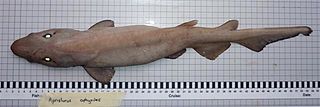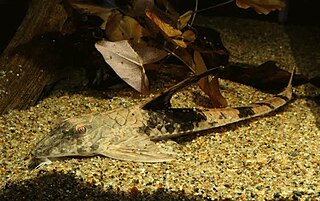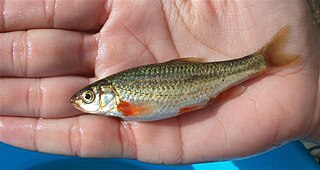
Hypostomus is a genus of catfish in the family Loricariidae. They are native to tropical and subtropical South America. H. plecostomus is the popular freshwater aquarium fish formerly known as Plecostomus plecostomus. The taxonomic structure of the Loricariidae is still being expanded by scientists. Hypostomus is a highly species-rich and widely distributed catfish genus.
This glossary of ichthyology is a list of definitions of terms and concepts used in ichthyology, the study of fishes.

The white ghost catshark is a shark of the catshark family Pentanchidae, the deepwater catsharks. This shark is found in deep water in the northeast Atlantic between latitudes 57°N and 58°N. A deep-water catshark known from the eastern North Atlantic from depths of 1,014 to 1,800 m, it is known from only a limited number of specimens. It reaches a maximum of 54 cm or 1.7 ft total length which is a medium size for the Apristurus genus.

Loricaria is a genus of armored catfish native to South America.

Chondrostoma is a genus of ray-finned fish in the family Cyprinidae. They are commonly known as nases, although this term is also used locally to denote particular species, most frequently the common nase . The common name refers to the protruding upper jaw of these fishes; it is derived from the German term Nase 'nose'.

Parachondrostoma turiense is a species of ray-finned fish in the family Cyprinidae. It is found only in Spain. Its natural habitat is rivers. It is threatened by habitat loss.
Breitensteinia is a genus of catfishes of the family Akysidae. It includes three species.
Sternarchogiton nattereri is a species of weakly electric knifefish in the family Apteronotidae. It is native to the Amazon River system and feeds on sponges. Unlike other members of the genus Sternarchogiton, there is pronounced sexual dimorphism in S. nattereri, with reproductively mature males developing strong external teeth on tips of their jaws. These males are so different from the females and juveniles that they were thought to be a different genus and species, the "tooth-lip knifefish" Oedemognathus exodon, for over 40 years.
Sternarchogiton porcinum is a species of weakly electric knifefish in the family Apteronotidae. It is native to deep river channels in the Río Huallaga, Río Napo, and Río Amazonas in Peru, and in the Río Orinoco in Venezuela. Many specimens once identified as S. porcinum from the Brazilian Amazon Basin and the Venezuelan Orinoco are now known to be a different species, S. preto.

Achondrostoma is a genus of freshwater fish in the family Cyprinidae, the carps and minnows. It is endemic to the Iberian Peninsula.

The Chihuahua shiner is a species of freshwater ray-finned fish from the family Cyprinidae, the carps and minnows. It is found in southern Texas and northern Mexico.
The phallic catshark is a species of shark belonging to the family Pentanchidae, the deepwater catsharks. It is found on or near the ocean floor, in the deep waters off New Caledonia and Vanuatu. A slender species attaining a length of 46 cm (18 in), it is characterized by a long caudal fin bearing a crest of enlarged dermal denticles along the dorsal margin, and very long claspers in adult males. This shark is gray-colored, with four dark saddles along the back and tail.

The speckled chub is a species of freshwater fish in the family Cyprinidae of the order Cypriniformes, which also includes carps, suckers, and loaches.

Iberochondrostoma is a genus of cyprinid fish endemic to the Iberian Peninsula.

Squalius janae, commonly known as the Istrian chub, is a species of freshwater fish in the carp family Cyprinidae. It was first described in 2010 from the Dragonja River drainage in Slovenia. Since then they have also been found in the Boljunčica and Pazinčica river drainages in Istria, Croatia.

Squalius valentinus, commonly known as the Valencia chub and the Levantine bagra, is a species of freshwater fish in the carp family Cyprinidae. It was first isolated from the Turia River in Valencia, hence its name. It is considered endangered. This species is differentiated from its cogenerates by having eight branched rays in its dorsal fin; eight branched rays in its anal fin; two rows of pharyngeal teeth on both sides possessing 2 and 5 teeth ; a wide caudal peduncle; its number of gill rakers; the number of scales in its lateral line; the number of scale rows above the latter; by possessing three scale rows below it; by having thirty-nine vertebrae ; showing large 4th and 5th infraorbital bones; a maxilla with a very distinct marked anterior process; exhibiting a frontal bone expanded at the middle; a wide neurocranium bone; the lower branch of the pharyngeal bone being robust; a large and narrow urohyal; as well as genetic differences (allozymes).

The humpback mahseer is a species of freshwater ray-finned fish from the Indian endemic genus Hypselobarbus in the carp and minnow family Cyprinidae.
Labeo heladiva, is a species of freshwater fish in the family Cyprinidae. It is endemic to Sri Lanka. Earlier considered as the same species as Labeo dussumieri in India, recent phylogenetic and physiological differences suggest that Sri Lankan population is a distinct species.
Archolaemus luciae is a species of glass knifefish endemic to Brazil where it is found in the Rio Jari, the Rio Trombetas and the Rio Tapajós basins in the eastern Amazon. Also found in the Rio Araguari. This species reaches a length of 49.7 cm (19.6 in).

Scoloplax dicra is a species of spiny dwarf catfish found throughout the river basins of South America.














